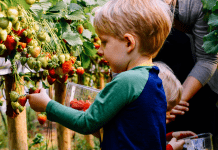Deciding what to make for dinner is a tough decision for all moms. Not only do we have to find something that everyone in our family will like, but it has to be somewhat nutritious, and not the same old thing that we make every single day. Me personally, I hate getting into a food rut. I like trying new things, and the last thing I want is for my kids to end up as insanely picky eaters who will be 16 and still eating just macaroni and cheese with chicken nuggets. (Yes, I know actual teenagers this picky.)
I wanted to try something fun and different, that would get all of us to try some new foods, and be exciting for my kids. That’s when I had a stroke of genius: Dinner Through the Decades! Or at least, that’s what I decided to call it.
We’ll be time traveling through culinary history, starting in the years 1900 – 910. And we’ll make our way through current day, with each meal consisting of the dishes and meals that were popular during those periods. The goal is to expand our horizons, make dinner a fun opportunity to do a little learning, and all of us — kids and adults alike — try some new things we wouldn’t have tried otherwise. (I’m already dreading the mid-century monstrosities.)
READ: Ice Cream Spots In and Around South Central PA
So how did our first dinner experiment go? I did a lot of expert research, consulting the foremost expert in the field, Dr. Google, and found some dishes that were popular during this decade. It was a little surprising; some dishes seemed about what I expected, like chicken pudding, while others, like Jell-o, were not. But did the kids like it?
Surprisingly, yes. Most of the things I made went over really well, especially the Jell-o. I was a bit nervous while cooking everything — the stuffed eggs included “onion juice,” for example — but it ended up going really well. The kids were super excited to try everything, even my pickiest eaters, who were up to try things they might otherwise turn their noses up at, and they liked it all, for the most part. Most of the food was, unlike our meals of today, fairly plain. This makes sense, given the time period, but it was still better than I expected it to be. Everyone is already excited to travel on to our next decade: the 1910s!
Read on for info on each individual dish, and links for the recipes I used!
Chicken Pudding
This dish came up a lot, and I ended up using a recipe from George Washington’s Mount Vernon. And I gotta say, I think knowing George Washington ate this at dinner helped my kids be more open to trying it.
The recipe called for a roast chicken, but I was feeling lazy, so I just got myself a couple of rotisserie chickens from Giant and just shredded the meat in those instead. The basic gist of the recipe was, using butter and flour, make a roux, and then stir in chicken broth. Then you add milk and eggs, fold the chicken in, and bake it. It looked… OK? I was nervous, because it just didn’t look particularly appetizing, both before cooking and after. But it actually wasn’t bad! It was filling without being heavy, and yes, it was plain, but it wasn’t bland. Every single one of my kids really liked it.
Find the recipe for chicken pudding here.
Ambrosia
I was definitely groaning when I saw ambrosia came up so much. I think we all recognize ambrosia being the terrible concoction that circulates so much today, especially if you’re from the south or the midwest. It’s fruit, sort of, but mixed in with a ton of marshmallow fluff, nuts, maraschino cherries, Cool Whip, coconut… it’s just a lot, and it’s not my thing.
Fortunately, ambrosia in the 1900s was very different, and much simpler. There are only three ingredients: oranges, fresh coconut, and sugar. That’s literally it. It was so easy to make, too! All I had to do was chop up the oranges, and toss them with the coconut and sugar. The kids didn’t dislike this one, but they didn’t love it, either; most of them aren’t super into coconut. But it was a hit with my husband, who said it was a perfect dish for summertime: light, refreshing, and sweet.
Find the recipe for ambrosia here.
Jell-O
Yes, Jell-O! We all know and love it, but I had no clue it originated in the 1900s. A lot of the companies we’re so familiar with today — Nabisco, Campbell’s, General Mills, Quaker Oats, Kraft, and more — were founded during this decade, and Jell-O was one of them. It was incredibly popular, although people hadn’t yet started putting meat and vegetables into non-flavored gelatin (thank God).
Instead, it was just regular old Jell-O, which of course, the kids loved. Us grown-ups weren’t as psyched about it, but it still gave us the chance to talk about food origins and history. It was fun for them to imagine kids eating the same snack they were eating, over 100 years ago.
Stuffed Eggs
So, we all love deviled eggs, right? I mean, it’s basically one of the best foods ever. Well, in the 1900s, deviled eggs weren’t quite invented yet, but something similar was, and that’s stuffed eggs. Essentially, you make something like deviled eggs, but you put the eggs back together with the filling in the middle, toss them in breadcrumbs, and then fry them.
Fried deviled eggs? Yes, please!
The filling had me a little bit wary; it involved onion juice, which is fine for me and my husband, but I worried that the flavor would be too overpowering for the kids. In addition to the onion juice, all that was added to the egg yolks was butter and cream. Very simple, very plain. The breadcrumbs didn’t work as well as I had hoped; they didn’t adhere to the eggs like… at all, and since I was following specific recipes and trying not to use my 2023 knowledge, I didn’t improvise at all. So they weren’t the nice crispy deviled eggs I was expecting. But you know what? They still tasted good! They all went super fast, and everyone loved them. We might try it again, but with regular deviled egg ingredients, and a better method for frying them.
Get the recipe for stuffed eggs here.
Watermelon and Corn
No, not together! But these were what I opted for to complete our meal, given that I wanted to make sure there was something nutritious on the table, and these were apparently common side dishes in the 1910s. (Other options? Cauliflower, fried tomatoes, sweet potatoes, plum sauce, cabbage salad, and so on.) I opted for watermelon and corn, because they fit the bill — something commonly eaten in the 1900s — and I knew my kids would like it.
Hey, I didn’t want to go too crazy with making my kids try new things!
Overall, our first Dinner Through the Decades experiment was a massive success, and I’d definitely encourage anyone else to try it out with their family if they felt adventurous. We had so many great conversations during that meal: what did people do during dinners in the 1900s, for example? Why were the dishes, relatively speaking, so much plainer and simpler than what we’re used to? It was a great way to not only try some new foods, but have a new fun family experience, and learn something along the way! And we can’t wait to see what the 1910s bring us next.




